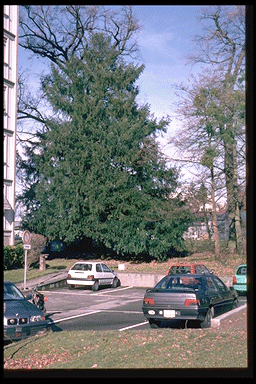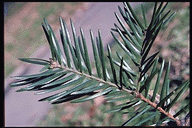Torreya californica
Isolated Specimen in Geneva - Switzerland




This Nutmeg species is a Califonia endemic - see Range Map.
The seeds are contained in a fleshy enveloppe (a drupe) with a light green colour (with lighter, almost white stripes at maturity), when fresh. It is very aromatic, with a pleasant flavour. The drupes are typically up to 4.5 cm long and up to 3.5 cm wide. They are easily crushed open with the fingers to take the seed away. The seeds are up to 4 cm long (usually between 3 and 4 cm) and up to 2.3 cm wide. Fresh and hydrated seeds weight 7.6 grams (average). There is some variability as well for the form as for the length/width rate. The seed colour is light brown when the seedcoat is dry, and brown when it is wet. The seedcoat is slightly wrinkled, except at one end, where a shield is appearing. At maturity the drupes will fall to the ground, usually in the second half of September. As soon as the envelop will open, the seedcoat will be colonized by micro-organisms (hence the usual darker dots on the seeds collected on the ground after some days) It will not affect the quality of the seed very well protected by its coat (on the other side a boken seedcoat will not make the seed viable anymore). In the literature, Torreya californica is described sometimes as dioecious. The tree in Geneva is monoecious. Small males inflorescenses are light yellow, almost white.

The crop can be quite abundant - several kilogramms - in a good year.
Last crops in Geneva :
1997 : good crop
1998 : very good crop
1999 : very bad crop
2000 : very good crop - more than 32 kg
In the literature, it is said that the seeds need 2 years to mature. There is no evidence of that. On the contrary. End of Winter and Spring 1999 were very cold and rainy, while the 1998 and 2000 seasons were optimal (especially 2000) for plant growth and pollinization. If the maturity would take 2 years, it could not explain the data for the crops of these 3 last years. There is a direct link between the meteorological conditions of the beginning of the year and the crop of the same year. Also no seeds (even very small) can be seen on the tree after the month of October. The growth of the seeds is very quick from Spring to the end of Summer.
 Sowing : fresh seeds will germinate within 18 months. Keep the seeds moist and in the refrigerator or sow them immediately after soaking them in tap water the time necessary for the seeds to fall to the bottom. Sow the seeds flat, the root will come out on the side* opposite to the 'sharp-pointed' end (*there is like a shield with two small 'eyes' next to it). Keep the pots with the seeds moist without excess, outside in a sheltered place (without sunlight, and frost free). If the seeds will dry too much and be stored for a too long time, they will not rehydrate themselves. Some moist seeds kept in the refrigerator will begin to germinate even at temperatures lower than 5° C. Some seeds sown in Fall will begin to germinate in August of the next year, and almost all remaining seeds will germinate the second Spring. The germination is
hypogeal. There are 2
cotyledons never coming completely out of the seedcoat.
Sowing : fresh seeds will germinate within 18 months. Keep the seeds moist and in the refrigerator or sow them immediately after soaking them in tap water the time necessary for the seeds to fall to the bottom. Sow the seeds flat, the root will come out on the side* opposite to the 'sharp-pointed' end (*there is like a shield with two small 'eyes' next to it). Keep the pots with the seeds moist without excess, outside in a sheltered place (without sunlight, and frost free). If the seeds will dry too much and be stored for a too long time, they will not rehydrate themselves. Some moist seeds kept in the refrigerator will begin to germinate even at temperatures lower than 5° C. Some seeds sown in Fall will begin to germinate in August of the next year, and almost all remaining seeds will germinate the second Spring. The germination is
hypogeal. There are 2
cotyledons never coming completely out of the seedcoat.
Picture at the right : actual size (for a screen 800x600) of the germinating seedling. The leaves, still white, were not yet out or the earth. Notice the visible cotyledon remaining in the seedcoat.
The roots are unusually thick, yellowish. They will break easily and will not keep the medium well together if taken out of the tube or pot.
Regeneration : the tree in Geneva, although alone of its kind, regenerate abundantly. Many seedlings are to be seen under it. Even when cut by a lawn mover, the seedlings will form a new growth from lower hidden buds.
Enemies : it is necessary to protect the seeds from mice and birds, even if the seeds are burried some centimeters below the soil surface. After germination the leaves will be very tender and many insects and slugs will be fond of them. Again protection is quite necessary. No disease was seen so far.
Experiment : some seeds were sown directly at one place in the Arboretum (Bouno Mort Unit) with protections under the soil surface as well as above it (wire fence below, plastic net above) and left alone. The nature alone cared about the rest and now 3 seedlings are growing at this place. Freezing did not affect the seeds. The same experience was repeated in Spring 2000 : 10 seeds were sowed at 7 different places. The protection was minimal (small plastic nets above the soil - some of them were thtown away by animals). In Fall 2000 all 7 places showed at least one seedling emerging from the soil.
Growth : the growth is very slow (compared to most other trees). Plants grown from seeds will develop into beautiful trees, while cuttings will usually remain low shrubs.
Hardiness : the usual rating for this tree is 8 (Krüssmann and Rushforth, while the RHS Dictionary of Gardening gives 7). Geneva is zone 8a. Frost went down to -18° C. The tree is near a building and a few other Angiosperm trees are giving it an hypothetical shelter from the cold North-East wind.
Habits : this species is said to like shade. Although it is true that it can accept heavy shade, the growth will be quite slow under this condition. It can accept very well at least half-day full sunlight and it will grow better (experience at 46° latitude and 400 m altitude !).
 Leaves : the leaves can be to 8 cm long and to 4 mm wide. The tip of the leaves is needle sharp. There is no midrib on the upper surface, unlike Cephalotaxus species. There are two whitish bands on the lower side of the leaves, found into a depression from the surface.
Leaves : the leaves can be to 8 cm long and to 4 mm wide. The tip of the leaves is needle sharp. There is no midrib on the upper surface, unlike Cephalotaxus species. There are two whitish bands on the lower side of the leaves, found into a depression from the surface.
 Stobili : females strobili in january display a light violet colour and are still closed. Size : about 1 cm.
Stobili : females strobili in january display a light violet colour and are still closed. Size : about 1 cm.
Leaves, upper side.
Leaves, lower side.


Photos & text : © Arboretum de Villardebelle
24 September 2000
 Sowing : fresh seeds will germinate within 18 months. Keep the seeds moist and in the refrigerator or sow them immediately after soaking them in tap water the time necessary for the seeds to fall to the bottom. Sow the seeds flat, the root will come out on the side* opposite to the 'sharp-pointed' end (*there is like a shield with two small 'eyes' next to it). Keep the pots with the seeds moist without excess, outside in a sheltered place (without sunlight, and frost free). If the seeds will dry too much and be stored for a too long time, they will not rehydrate themselves. Some moist seeds kept in the refrigerator will begin to germinate even at temperatures lower than 5° C. Some seeds sown in Fall will begin to germinate in August of the next year, and almost all remaining seeds will germinate the second Spring. The germination is
hypogeal. There are 2
cotyledons never coming completely out of the seedcoat.
Sowing : fresh seeds will germinate within 18 months. Keep the seeds moist and in the refrigerator or sow them immediately after soaking them in tap water the time necessary for the seeds to fall to the bottom. Sow the seeds flat, the root will come out on the side* opposite to the 'sharp-pointed' end (*there is like a shield with two small 'eyes' next to it). Keep the pots with the seeds moist without excess, outside in a sheltered place (without sunlight, and frost free). If the seeds will dry too much and be stored for a too long time, they will not rehydrate themselves. Some moist seeds kept in the refrigerator will begin to germinate even at temperatures lower than 5° C. Some seeds sown in Fall will begin to germinate in August of the next year, and almost all remaining seeds will germinate the second Spring. The germination is
hypogeal. There are 2
cotyledons never coming completely out of the seedcoat.






 Stobili : females strobili in january display a light violet colour and are still closed. Size : about 1 cm.
Stobili : females strobili in january display a light violet colour and are still closed. Size : about 1 cm.
